Already widely adopted as a key strategic initiative by many organisations, digital transformation has taken on heightened importance in the wake of the coronavirus pandemic. According to an IDG Research business impact survey conducted in July, 59% of 373 IT decision makers say that pressures stemming from COVID-19 are accelerating their digital transformation efforts, while 76% of executives agree that organisations need to dramatically reengineer the experiences that bring technology and people together in a more human-centric manner, as reported by Accenture.
Introduction
As a global innovation consultancy specialising in preparing leadership and culture for the future, we get many requests from executives of mid-size companies, enterprises and government agencies to help them with their digital transformation initiatives. These initiatives are usually in the form of big bold dreams that these companies are trying to manifest. Naturally, my team of change management coaches and I started to ask ourselves: what would resonate with them as much as it did with us?
Drawing inspiration from John F. Kennedy’s famous “We choose to go to the Moon” space speech, which roused the nation into supporting an incredibly ambitious idea, we started using this narrative as a visioning and alignment technique with our clients.
This blog post will introduce you to “We choose to go to the Moon,” our modified version of the original agile activity as a visioning, alignment and change roadmap exercise that we facilitate with clients through deep democratic remote facilitation techniques and templates. I will also cover the basics of the techniques, as well as facilitation tips, common pitfalls to avoid, and finally share some expert advice on how you can customise it further to suit your own context.
As a bonus, you can download the remote facilitation toolkit (the PDF as well as the Miro Template) at the end of this article to immediately get started on accelerating your growth.
Let’s begin!
Context
Through our work over the years, we’ve noticed that our clients (usually banks, insurance companies and financial institutions) often have big and bold ambitions. However, most of the time, they enter a state of analysis paralysis, and struggle with defining a vision, communicating it inspiringly, aligning initiatives around this vision, creating a roadmap and moving to small experiments. In order for digital transformations to take flight, we need to push past this stagnation point and move forward.
Objective
As mentioned, the idea of this activity is to help envision and align decision makers on their next big dream. At PALO IT, it is usually applied for our digital, business, agile or cultural transformation initiatives. However, this technique can also be used for any given context where visioning and/or alignment is needed, such as envisioning a personal project or even your next staycation!
Outcome
We believe that by facilitating this activity, for executives and the senior leadership team, they will achieve clarity, focus, alignment and a sense of direction on what the transformation means to their company and what it entails. We would know this is true when we see them engage in powerful conversations, iterate between dream and reality and come out with a plan of realistic experiments they would like to run in the immediate quarter.
Template & Steps
Here’s the full template of the activity and 7 steps.
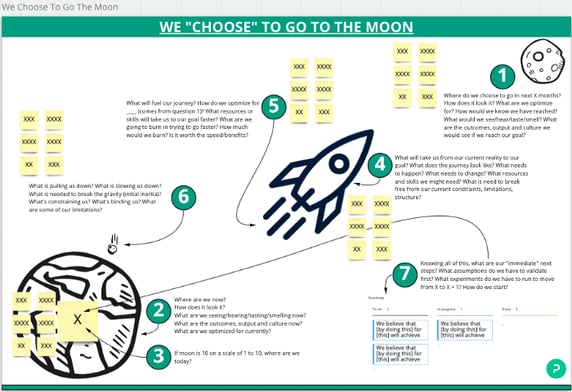 Miro template of We Choose To Go To The Moon
Miro template of We Choose To Go To The Moon
Now let's go through each step one by one.
1. What's your Moon?
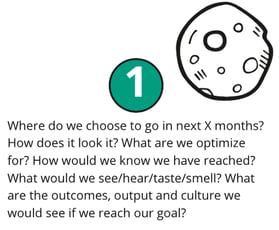
The first step is all about getting decision makers to dream, followed by articulating their dreams into words. Explain it, express it, enact it. This is an opportunity for the sponsor to inspire other leaders with his/her vision from the onset.
Questions To Ask:
- What’s your Moon? What’s your vision?
- Where do you choose to go in the next X months?
- How would we know we have reached the Moon?
- Suppose you have reached your goal, your vision has manifested. How does it look?
- What are the outcomes, output and culture that we would see?
Other Possible Questions:
- What do we already know about the Moon? What are the known unknowns?
- What risks do we envision?
- What kind of people/product/skills can we expect here?
- Who else is trying to go to the Moon? (competitors) Who would we find on the Moon? (competitors/pioneers who have already reached the Moon)
2. What's your Earth?
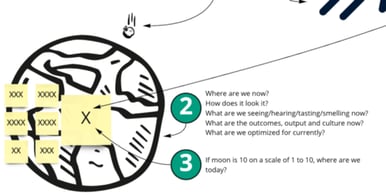
Alright, it’s time to bring your decision makers back to Earth :) You now know where you want to go, but do you know where you are?
Questions To Ask:
- Where are we now?
- What does the current reality look like?
- What are we seeing, hearing and feeling now?
- What are the outcomes, output and culture now?
- What are we optimised for now?
Other Possible Questions:
- How’s the Earth for you?
- What’s beautiful on Earth now?
- If we do not choose to go to the Moon, where would we be?
- What’s the cost of staying on Earth for the next X months / years?
3. If the Moon is 10 on a scale of 1 to 10, where are we today?
Decision makers love numbers and scales. Scaling and rating this way helps them reflect on how close or far they are to the Moon. Most of the time, they will not say 0. This is another revelation and a coaching moment — everything is not bad. Even though we want to go to the Moon, let’s pause and acknowledge what’s beautiful on Earth!
4. What's our rocket?
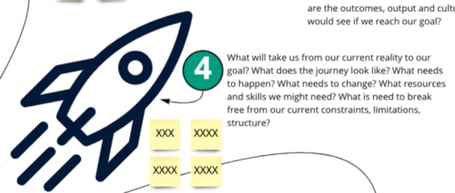
This is where it starts to get exciting — we are lifting off from Earth and dreaming again. Now that we know what our current reality is and where we want to go, what might take us there? Where is our rocket? What is our rocket which will take us there?
Questions To Ask:
- What will take us from our current reality to our goal?
- What does the journey look like?
- What needs to happen?
- What needs to change?
- What resources and skills we might need?
- What is needed to lift-off? To break free from our current structure, limitations and constraints?
Other Possible Questions:
- What does it feel like in the rocket?
- Who are the possible astronauts?
- What are the risks and the troubles that the rocket might go through?
- Describe the rocket’s journey quarter by quarter for the next 2 years
- What would be the rocket’s trajectory quarter by quarter for the next 2 years?
- What should be the speed of the rocket? At what speed do you think it will go in reality?
- When shall we launch?
5. What is pulling us down?
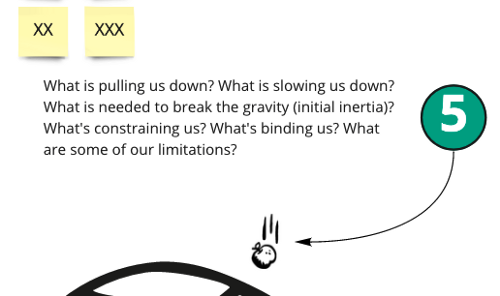
We have an idea of the rocket and it’s journey, but a strong force is pulling it down. Gravity. Inertia. This is the same force that provides a stable base for the rocket to stand upright. On the other hand, it’s also the same force that tries to pull it down.
Questions To Ask:
- What’s pulling us down?
- What’s slowing us down?
- What’s constraining us?
- What’s holding us back?
- What are some of our limitations, constraints, blind spots, weaknesses?
Other Possible Questions:
- What’s keeping us upright and stable?
- What might keep the rocket upright and stable till lift off?
- How might we keep the rocket upright and stable till lift off?
- What force will take care of the Earthlings (current projects/endeavours) and keep it stable?
- How high/far should the rocket be to be free from this force?
- Has it happened before in the company for any other initiatives? How did it go? What were the learnings?
6. What will fuel our journey

Needless to say, we need fuel for the rocket. We might need to burn a lot more fuel initially than in the later stages as we need enough to beat the gravity and initial inertia.
Questions To Ask:
- What will fuel our journey?
- How do we optimise for ____ (comes from question 1)
- What resources or skills will take us to our goals faster/safer/cheaper?
- What are we going to burn (read invest) to go faster?
- How much would we burn?
- Is it worth the speed/benefits?
Other Possible Questions:
- What is the cost of this fuel?
- Where do we find the fuel?
- How much fuel might be needed?
7. What are our next steps?
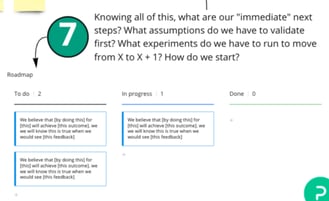
Congratulations for surviving this far! We now know where we want to go, where we are, what will take us towards our goals, what we need to invest in, and what forces/constraints we need to break free of. It’s time for some action. As we have never been to the Moon before, let’s write them as hypotheses / experimental statements.
Questions To Ask:
- Knowing all of this, what are our immediate next steps?
- What assumptions are we making?
- What assumptions do we have to validate/invalidate early and upfront?
- What are a few experiments we should run tomorrow to move from X to X + 1?
- How do we start?
- Where do we start?
Other Possible Questions:
- What and how much fuel do we need to do the first few iterations?
- Do we need a control tower on Earth? What does it look like?
Common Pitfalls and Their Antidotes
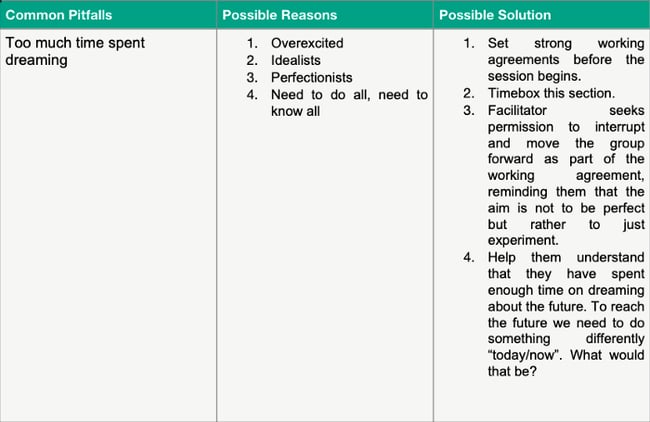
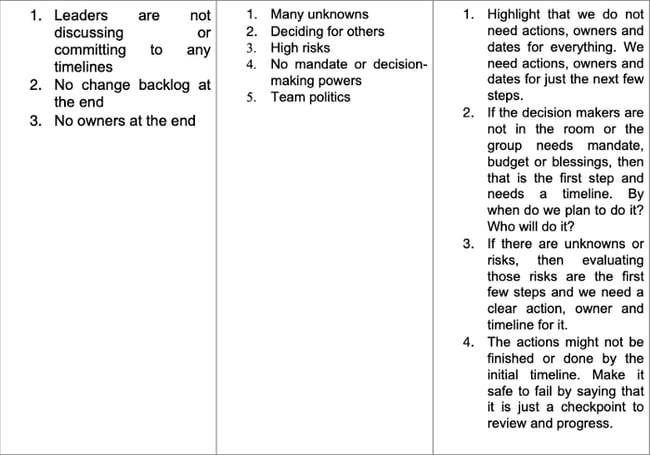
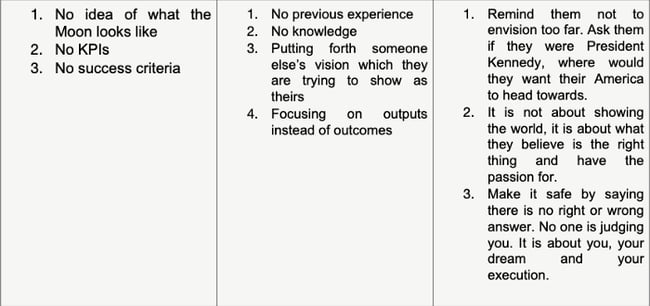

Remote Facilitation Tips & Customisations
For general remote facilitation tips, refer to Remote Facilitation Tips By Session Lab.
Here are some tips designed specifically for this activity:
- Make sure you have a good mix of leaders and senior executives in the room. They should represent different departments, levels and geographical locations. It’s a good idea to also include a few trusted, vocal critics from the trenches as well (non-leaders and senior executives) to ensure a fair representation of the company.
- Do the whole exercise as part of an offsite OR break the activity into multiple parts but not more than 4 * 90–120 min sessions. Also try not to spread it beyond 2 weeks if you are breaking the exercise into smaller sessions. We need the momentum and limit the time spent switching between different contexts to catch the thread from where we left off.
- Always ask leaders to write their thoughts on stickies, before clustering on a board and then discussing these clusters only.
- It’s beneficial to have an external, neutral, or expert facilitator to facilitate the session. An internal expert facilitator will do as well. However, internal facilitators will need to be experienced enough to maintain a distance and remain neutral.
To wrap things up, remember: facilitating this technique is not the goal. Goal is visioning, alignment, clarity and focus. This technique is just a tool. One of the means to an end. What techniques, tools, templates do you use for visioning and alignment? If you happen to use this technique or parts of it, we would love to hear your experience and learn. Please share your thoughts / comments and experience in the comments section below.
*Original version credit:
Original “We Choose To Go To The Moon” activity by Aurelien Morvant

This work is licensed under a Creative Commons Attribution 4.0 International License.